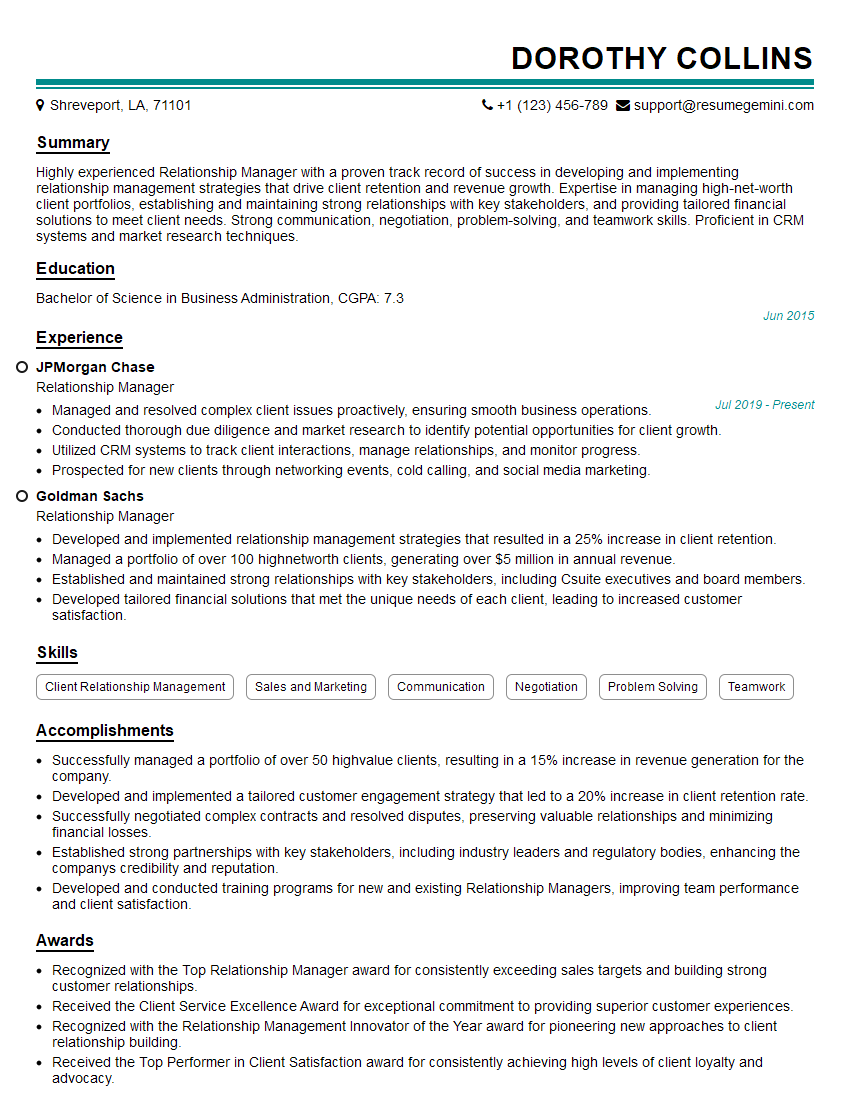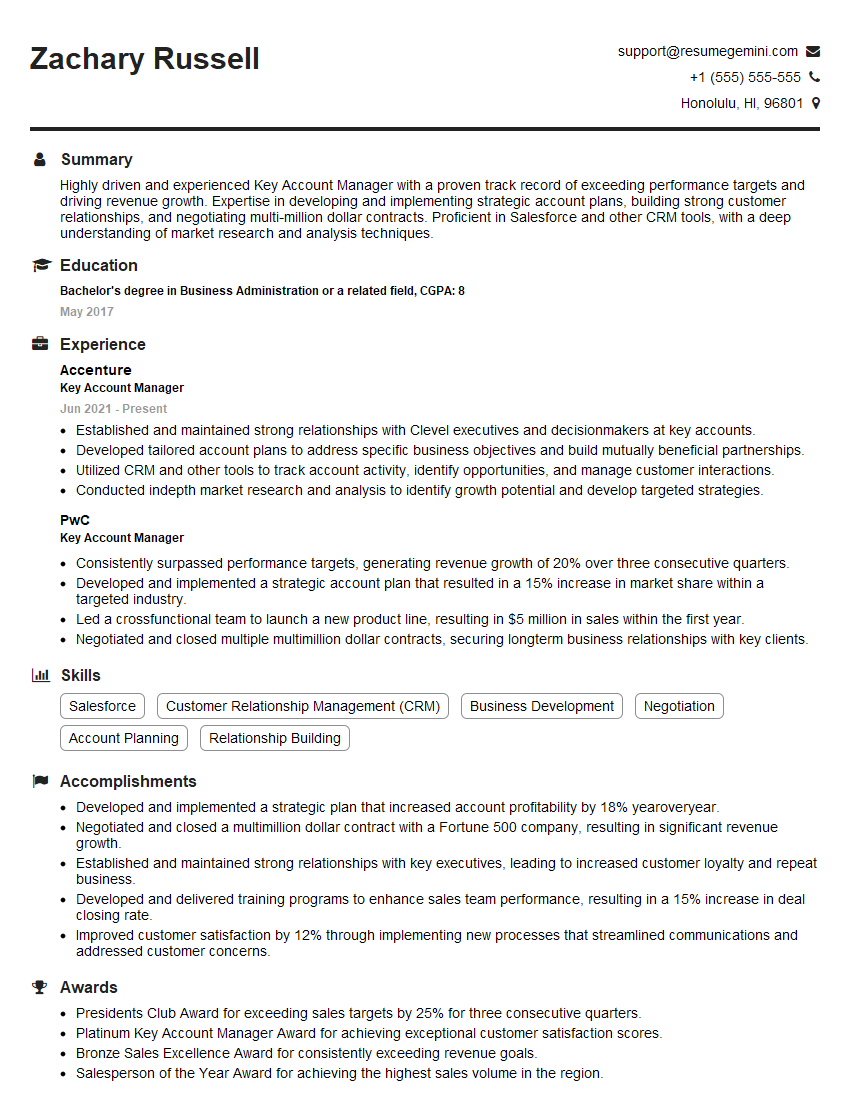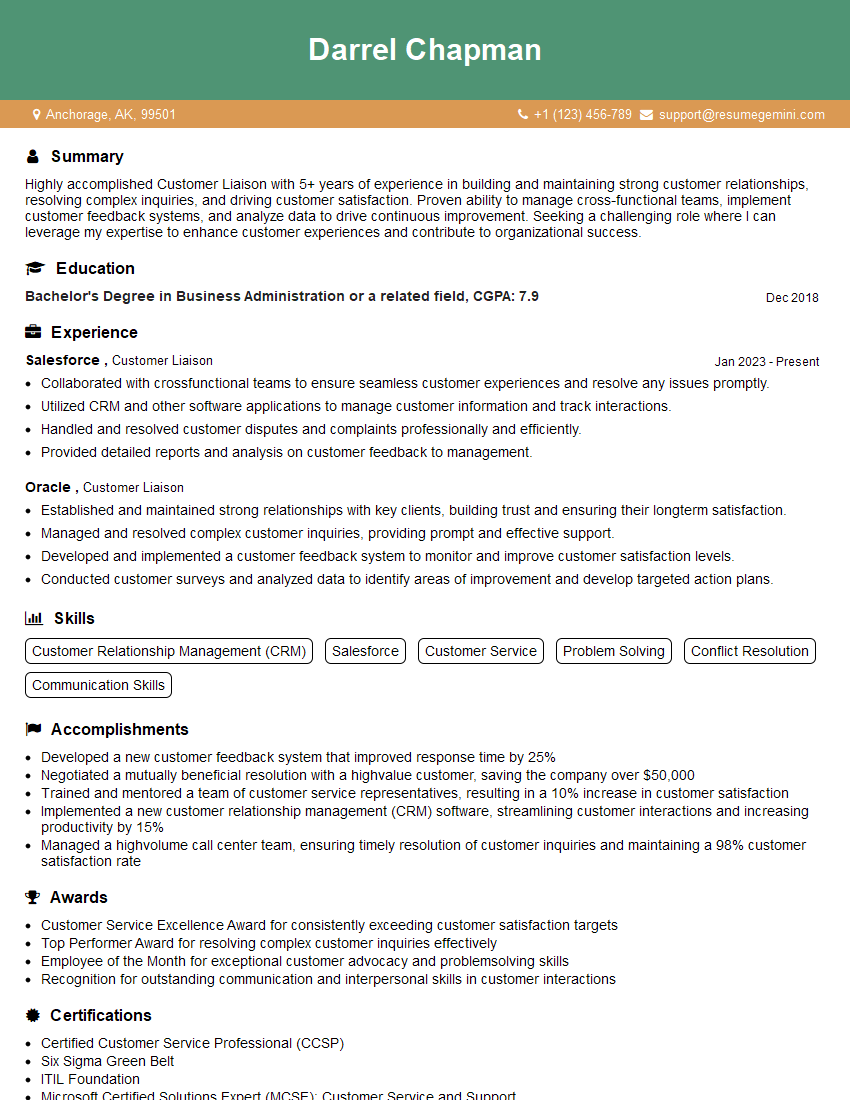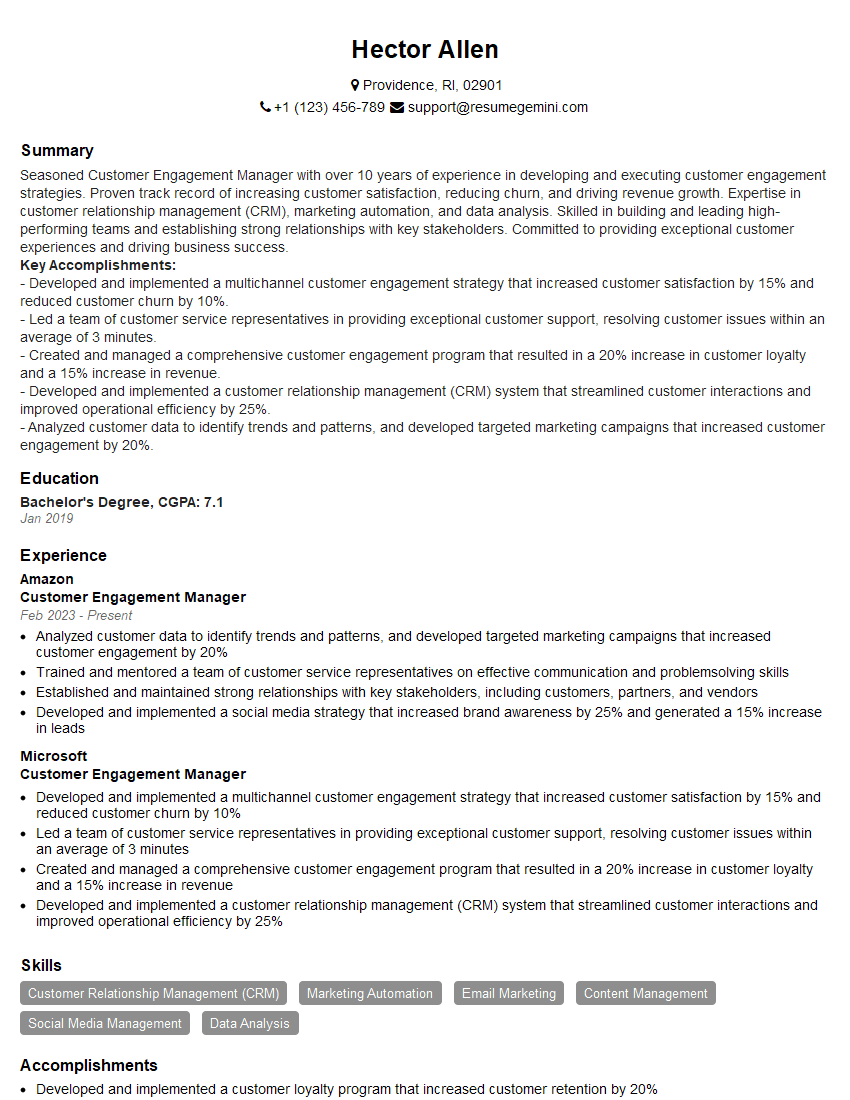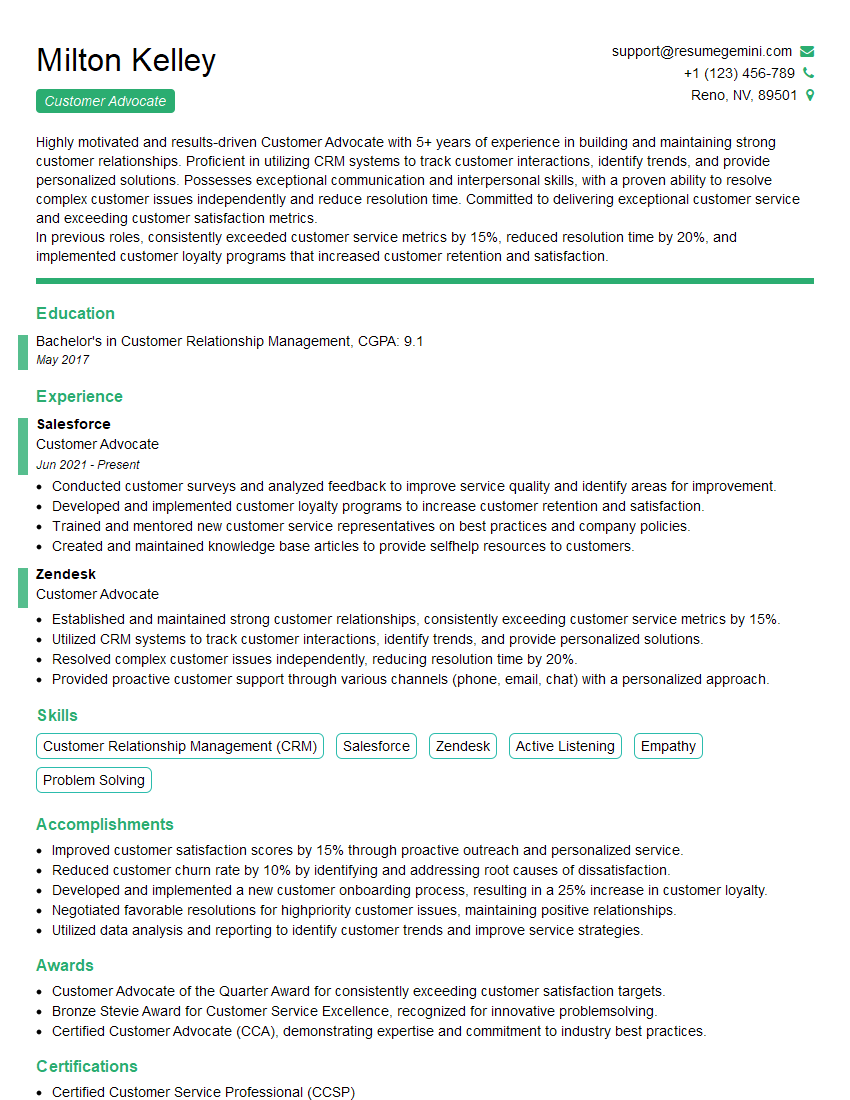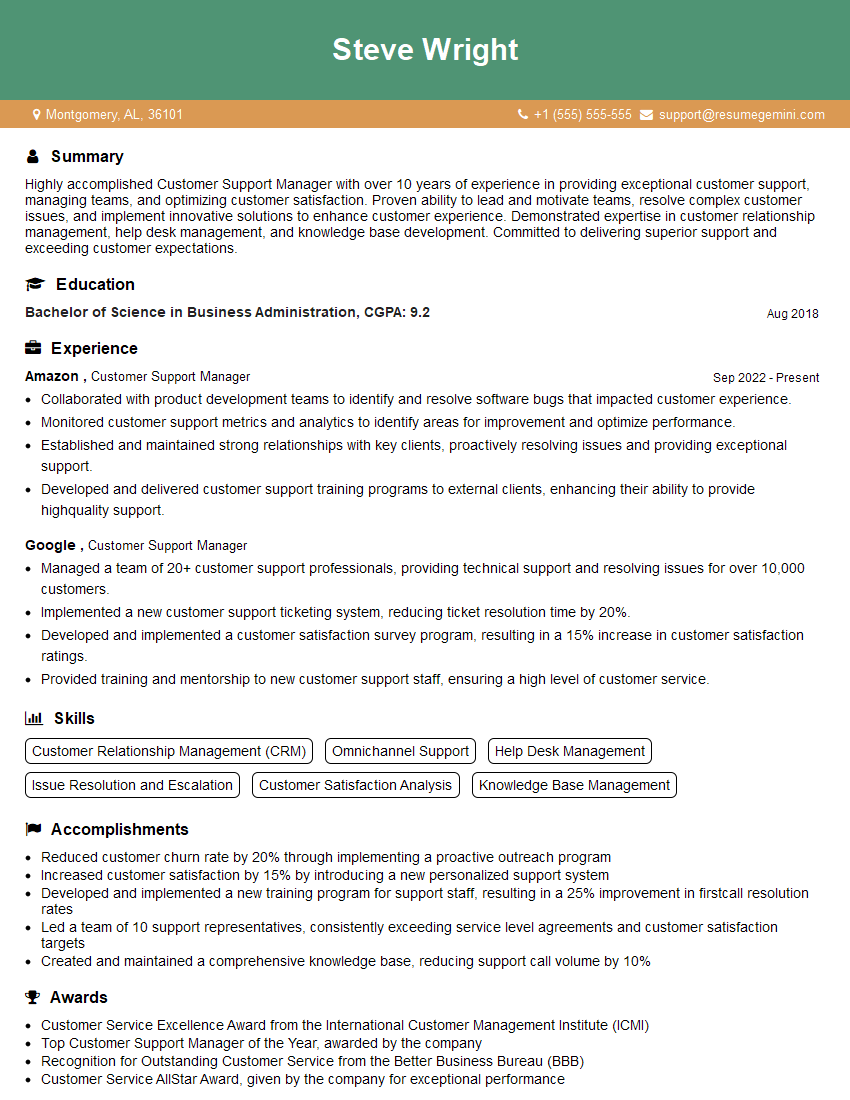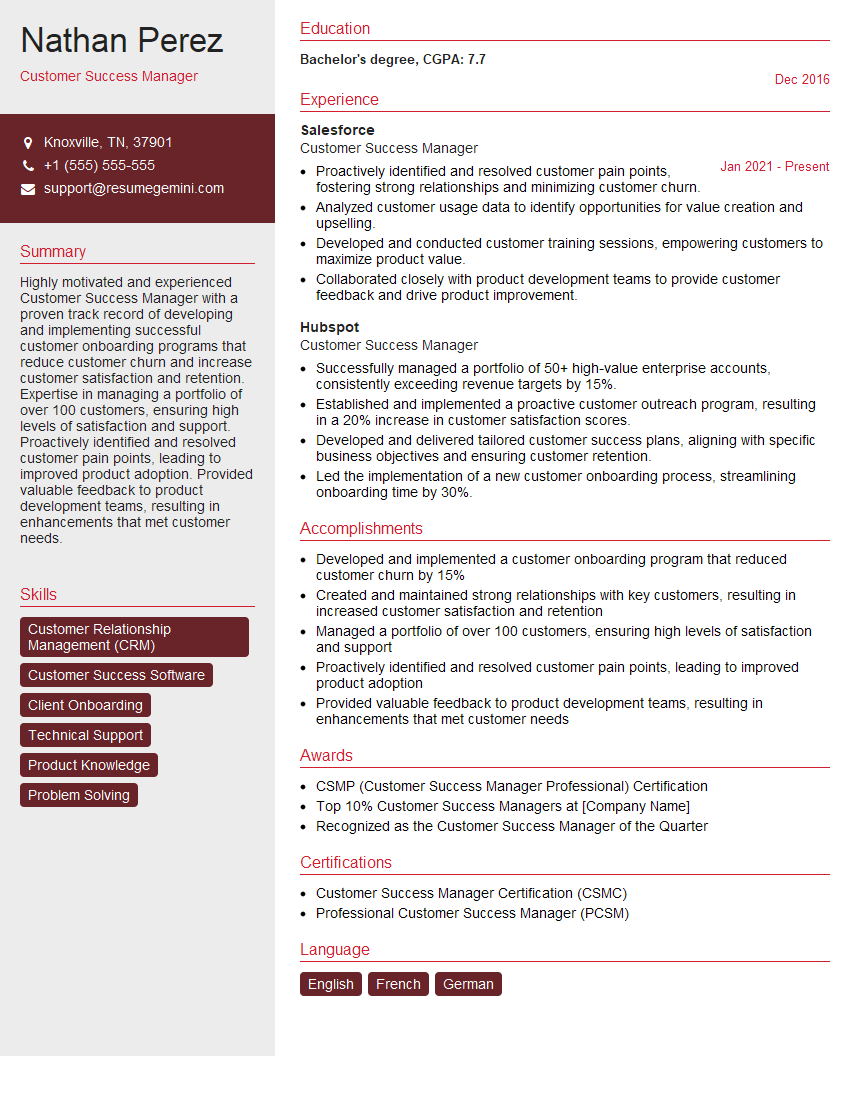Are you ready to stand out in your next interview? Understanding and preparing for Certified Customer Relations Manager (CCRM) interview questions is a game-changer. In this blog, we’ve compiled key questions and expert advice to help you showcase your skills with confidence and precision. Let’s get started on your journey to acing the interview.
Questions Asked in Certified Customer Relations Manager (CCRM) Interview
Q 1. Describe your experience implementing a customer relationship management (CRM) system.
Implementing a CRM system is a multifaceted process that goes beyond simply choosing software. It involves careful planning, stakeholder engagement, and a phased approach to ensure a smooth transition and user adoption. My experience includes leading the implementation of Salesforce at a previous company. This involved:
- Needs Assessment: We began by thoroughly analyzing our existing customer interaction processes, identifying pain points, and defining clear objectives for the CRM, such as improved lead management and enhanced customer service.
- Software Selection: We evaluated several CRM platforms based on factors like scalability, integration capabilities with existing systems (e.g., our marketing automation platform), and user-friendliness. Salesforce’s robust features and customization options made it the ideal choice.
- Data Migration: Migrating existing customer data was a crucial step. We developed a detailed data migration plan to ensure data accuracy and integrity, minimizing disruption to ongoing operations. This included data cleansing and validation procedures.
- Training and Support: We implemented a comprehensive training program for all users, covering everything from basic navigation to advanced features. Ongoing support and troubleshooting were critical to ensure smooth user adoption and address any technical issues.
- Post-Implementation Monitoring: After the launch, we closely monitored key metrics to assess the system’s effectiveness and make necessary adjustments. This included regular user feedback sessions and performance analysis.
The result was a significant improvement in our customer data management, leading to better sales forecasting and improved customer service response times. We saw a 20% increase in lead conversion rates within six months of implementation.
Q 2. How do you measure customer satisfaction and loyalty?
Measuring customer satisfaction and loyalty requires a multi-pronged approach, combining quantitative and qualitative data. I typically utilize the following methods:
- Customer Satisfaction (CSAT) Surveys: Regularly sending short surveys after interactions (e.g., post-purchase, after support calls) to gauge immediate satisfaction. These often use a simple rating scale (e.g., 1-5 stars).
- Net Promoter Score (NPS): This metric measures customer loyalty and willingness to recommend. It’s based on a single question: “On a scale of 0-10, how likely are you to recommend us to a friend or colleague?”
- Customer Effort Score (CES): This focuses on the ease of doing business with us. A lower effort score indicates higher satisfaction. A typical question is: “How easy was it to resolve your issue today?”
- Customer Reviews and Feedback: Monitoring online reviews (e.g., Google, Yelp) and actively soliciting feedback through social media channels provide valuable qualitative insights.
- Retention Rate: Tracking the percentage of customers who continue their business with us over time is a strong indicator of loyalty.
- Churn Rate Analysis: Understanding why customers leave helps identify areas for improvement and reduce churn.
By analyzing these metrics together, I can build a comprehensive picture of customer sentiment, identify trends, and prioritize areas for improvement.
Q 3. Explain your approach to handling difficult customer interactions.
Handling difficult customer interactions requires empathy, active listening, and a structured approach. My strategy involves:
- Active Listening: I begin by carefully listening to the customer’s concerns without interrupting. This shows that I value their perspective.
- Empathy and Validation: I acknowledge their frustration and validate their feelings, even if I don’t agree with their perspective. A simple phrase like, “I understand your frustration,” can go a long way.
- Problem Definition: I clearly define the issue from the customer’s point of view to ensure I fully grasp the situation. I might say, “So it sounds like you’re experiencing X because of Y.”
- Solution-Oriented Approach: Once the issue is understood, I focus on finding a resolution. This may involve offering a solution, escalating the issue to a supervisor, or offering compensation.
- Follow-up: After resolving the issue, I always follow up to ensure the customer is satisfied and to prevent future occurrences. This demonstrates ongoing commitment to their satisfaction.
For example, if a customer is angry about a delayed shipment, I wouldn’t get defensive. Instead, I’d apologize for the inconvenience, explain the reason for the delay (if possible), offer a solution like expedited shipping or a discount, and follow up to ensure the package arrives as expected.
Q 4. What metrics do you use to track the effectiveness of your customer relations strategies?
Tracking the effectiveness of customer relations strategies involves monitoring key metrics that provide insights into customer behavior and business performance. These include:
- Customer Satisfaction (CSAT) scores: As mentioned earlier, this provides a direct measure of customer happiness.
- Net Promoter Score (NPS): Indicates customer loyalty and willingness to recommend.
- Customer Churn Rate: Tracks the percentage of customers who discontinue their relationship with the company.
- Customer Lifetime Value (CLTV): Estimates the total revenue a customer will generate throughout their relationship with the company.
- Resolution Time: Measures the speed and efficiency of resolving customer issues. Faster resolution times often correlate with higher satisfaction.
- First Contact Resolution (FCR) Rate: The percentage of customer issues resolved on the first contact. A higher FCR rate reflects improved efficiency and customer service.
- Customer Acquisition Cost (CAC): The cost of acquiring a new customer; this is particularly relevant in evaluating the ROI of marketing and customer acquisition campaigns.
By analyzing these metrics regularly, I can identify trends, assess the impact of implemented strategies, and make data-driven decisions to improve customer relationships and overall business performance.
Q 5. How do you identify and address customer pain points?
Identifying and addressing customer pain points is crucial for improving customer experience and loyalty. My approach involves:
- Feedback Analysis: Thoroughly analyzing customer feedback from surveys, reviews, and support interactions to identify recurring themes and common complaints.
- Customer Interviews: Conducting in-depth interviews with customers to gain a deeper understanding of their needs, frustrations, and expectations.
- Data Analysis: Using CRM data to identify patterns in customer behavior, such as high churn rates in specific segments or frequent issues with particular products or services.
- Usability Testing: Conducting usability tests on products or services to identify areas where improvements can be made to enhance the customer experience.
- Social Media Monitoring: Tracking mentions of the company and its products/services on social media to identify customer concerns and potential issues.
Once pain points are identified, I work collaboratively with relevant teams (e.g., product development, marketing) to develop and implement solutions. For instance, if customer feedback consistently points to a confusing checkout process, I’d work with the web development team to streamline the process, making it more intuitive and user-friendly.
Q 6. Describe your experience with conflict resolution in a customer-facing role.
Conflict resolution is an inherent part of a customer-facing role. My approach is based on principles of fairness, empathy, and clear communication. I use a structured approach:
- Active Listening: I start by carefully listening to both sides of the conflict, allowing each party to express their concerns without interruption. It is key to try to understand their emotional state.
- Neutral Facilitation: I act as a neutral mediator, guiding the conversation towards a mutually acceptable solution.
- Identifying Common Ground: I try to find common ground between the conflicting parties and focus on areas of agreement.
- Exploring Solutions: I collaborate with the involved parties to brainstorm and evaluate different solutions, ensuring that all parties feel heard and involved in the process.
- Agreement and Documentation: Once a solution is reached, I document the agreement clearly and concisely, ensuring both parties understand and agree upon the terms.
For example, I once resolved a dispute between a customer and a delivery service by acting as a mediator. By actively listening to both sides, understanding their concerns, and proposing a compromise, I successfully resolved the conflict to everyone’s satisfaction.
Q 7. How do you prioritize competing demands from multiple customers?
Prioritizing competing demands from multiple customers requires a systematic approach that considers urgency, impact, and customer value. I typically use a prioritization matrix or framework such as:
- Urgency/Impact Matrix: This involves plotting each customer request on a matrix based on its urgency and its potential impact on the business or other customers. Requests with high urgency and high impact are prioritized first.
- Customer Segmentation: Prioritizing requests based on customer segmentation. High-value customers or those with long-term contracts might receive preferential treatment.
- First-In, First-Out (FIFO): A simple yet effective method for prioritizing requests based on the order they were received. While simple, this can lead to dissatisfaction if urgent requests are left unattended.
- Weighted Scoring System: Assign weights to different factors (e.g., urgency, impact, customer value) and calculate a score for each request. Requests with the highest scores are prioritized.
Transparency is key. I always communicate with customers about the prioritization process and provide realistic timelines for addressing their requests. This helps manage expectations and build trust.
Q 8. Explain your process for escalating customer issues.
My escalation process for customer issues is systematic and prioritizes timely resolution. It begins with attempting to resolve the issue at my level. If the issue is beyond my scope of authority or requires specialist knowledge, I follow a clearly defined escalation path. This typically involves documenting the issue thoroughly, including all relevant customer communication and attempted solutions. Then, I escalate the issue to my supervisor or the relevant department, providing them with all necessary information for a swift resolution. This ensures a smooth transition and maintains transparency with the customer. Regular updates are provided to the customer throughout the escalation process. For example, if a customer is experiencing a technical issue with software, I’d first troubleshoot common problems. If unsuccessful, I’d escalate to the technical support team, keeping the customer informed of the transfer and the expected timeline for a response. This structured approach minimizes customer frustration and ensures efficient problem solving.
Q 9. How do you maintain positive relationships with customers during challenging situations?
Maintaining positive customer relationships during challenging situations is crucial. My approach involves active listening, empathy, and a commitment to finding mutually agreeable solutions. I acknowledge the customer’s frustration and validate their feelings, making them feel heard and understood. Then, I clearly explain the situation, offering transparency and realistic expectations. This might involve outlining the steps I will take to resolve the problem, or explaining any constraints or limitations. I always maintain a professional and respectful tone, even under pressure. For example, if a customer is angry about a delayed delivery, I wouldn’t get defensive. Instead, I’d apologize for the inconvenience, explain the reason for the delay, and offer a solution, such as expedited shipping or a discount. By focusing on collaboration and a shared goal of resolution, I can transform even difficult situations into opportunities to strengthen the customer relationship.
Q 10. What strategies do you use to improve customer retention?
Improving customer retention involves a multi-faceted strategy focused on exceeding expectations and building loyalty. This starts with providing exceptional customer service during and after the sale. Proactive communication is key – regularly checking in with customers, offering helpful tips or resources, and celebrating milestones. Loyalty programs, exclusive offers, and personalized recommendations can also significantly enhance customer retention. Regular feedback collection, through surveys and reviews, provides valuable insights into areas for improvement. Acting on this feedback demonstrates a genuine commitment to customer satisfaction. Finally, building a strong customer community fosters a sense of belonging and increases engagement, encouraging long-term relationships. For example, a personalized birthday email with a special offer shows customers they are valued. Actively addressing negative reviews and turning those experiences into positive ones, showcases a dedication to continuous improvement.
Q 11. Describe your experience using customer feedback to improve products or services.
Customer feedback is invaluable for product and service improvement. I actively seek feedback through various channels – surveys, online reviews, social media monitoring, and direct customer interactions. This feedback is then analyzed to identify recurring themes, pain points, and areas for enhancement. For instance, if numerous customers complain about a specific feature’s complexity, it indicates a need for redesign or improved documentation. I ensure that all feedback, both positive and negative, is documented and shared with the relevant teams. This collaborative approach ensures that changes are implemented efficiently and effectively. We might use a system to track and categorize feedback, assigning priorities based on frequency and impact. The results of implemented changes are then monitored to gauge their effectiveness and iterate based on further customer feedback.
Q 12. How do you build trust and rapport with customers?
Building trust and rapport with customers begins with active listening and genuine empathy. I strive to understand their needs and perspectives, not just their immediate problems. This involves asking clarifying questions and reflecting back what I hear to ensure accurate understanding. Clear and concise communication, free from jargon, builds confidence. Honesty and transparency about potential limitations or challenges is crucial, as it fosters trust. Following through on commitments and being responsive to inquiries demonstrates reliability. Personalizing interactions where appropriate, remembering details from previous conversations, shows customers they are valued individuals, not just transactions. For example, addressing a customer by name and referencing a past interaction can create a positive and personalized experience.
Q 13. What techniques do you use to manage customer expectations?
Managing customer expectations is about setting realistic and achievable goals while maintaining transparency. Clearly communicating timelines, limitations, and potential challenges upfront prevents misunderstandings and disappointments. Regular updates and proactive communication throughout the process keep customers informed and engaged. When expectations cannot be met, it’s crucial to offer a sincere apology and a viable alternative or compensation. For instance, if a product is delayed, I would inform the customer proactively, explain the reason for the delay, and offer a revised timeline and a potential discount or alternative solution. By proactively managing expectations, I prevent negative surprises and build stronger customer relationships.
Q 14. How do you effectively communicate with customers from diverse backgrounds?
Effective communication with customers from diverse backgrounds requires cultural sensitivity and adaptability. This begins with recognizing and respecting individual differences in communication styles, language, and cultural norms. I strive to use clear and simple language, avoiding jargon and technical terms that might not be universally understood. Non-verbal cues, such as body language and tone of voice, also play a crucial role and should be considered carefully. When communicating with customers who speak a different language, I utilize translation services or bilingual team members to ensure accurate and effective communication. I also try to be mindful of cultural nuances that may impact how information is received and processed. For example, I might adjust my communication style to be more formal or informal, depending on the customer’s cultural background and preference.
Q 15. How do you handle complaints and negative feedback?
Handling complaints and negative feedback is crucial for maintaining positive customer relationships. My approach involves a structured process emphasizing empathy, active listening, and efficient problem resolution. I start by acknowledging the customer’s feelings and validating their concerns. This shows respect and sets a positive tone. Then, I actively listen to understand the issue fully, asking clarifying questions to avoid misinterpretations. Next, I work collaboratively with the customer to find a mutually agreeable solution. This might involve offering a refund, replacement, or other compensation, depending on the situation. Finally, I follow up to ensure the customer is satisfied and to gather feedback on the resolution process. For example, if a customer complains about a faulty product, I wouldn’t simply offer a replacement. I’d also investigate the root cause of the fault to prevent similar issues in the future, and potentially offer a small gift or discount as a gesture of goodwill.
A key element is documentation. Every complaint is carefully documented, including the customer’s contact information, the nature of the complaint, the steps taken to resolve it, and the outcome. This documentation helps to track trends, identify recurring issues, and improve customer service processes. This data informs process improvements, preventing similar issues from occurring again.
Career Expert Tips:
- Ace those interviews! Prepare effectively by reviewing the Top 50 Most Common Interview Questions on ResumeGemini.
- Navigate your job search with confidence! Explore a wide range of Career Tips on ResumeGemini. Learn about common challenges and recommendations to overcome them.
- Craft the perfect resume! Master the Art of Resume Writing with ResumeGemini’s guide. Showcase your unique qualifications and achievements effectively.
- Don’t miss out on holiday savings! Build your dream resume with ResumeGemini’s ATS optimized templates.
Q 16. Explain your approach to training and coaching customer service representatives.
My approach to training and coaching customer service representatives (CSRs) is multifaceted and focuses on building both hard and soft skills. I begin by establishing a clear understanding of our company’s customer service standards and values. This includes role-playing scenarios and providing examples of effective communication techniques. I then focus on product knowledge, ensuring CSRs are proficient in answering customer queries accurately and efficiently. Furthermore, I conduct regular coaching sessions that incorporate feedback from both customer interactions and internal assessments. This allows for continuous improvement and refinement of individual skills.
Soft skills are equally important. I emphasize the importance of active listening, empathy, conflict resolution, and de-escalation techniques. Training incorporates interactive exercises, such as role-playing difficult customer interactions to develop these critical skills. Regular feedback sessions and one-on-one coaching provide targeted support and address specific areas for improvement. We also utilize online training modules and resources that supplement our in-person training, ensuring ongoing learning and knowledge updates. Ultimately, I aim to cultivate a team of confident, knowledgeable, and empathetic CSRs who can consistently deliver exceptional customer experiences.
Q 17. What is your experience with customer segmentation and targeted communication?
Customer segmentation and targeted communication are essential for effective customer relationship management (CRM). My experience involves identifying distinct customer groups based on various criteria, such as demographics, purchase history, engagement levels, and customer lifetime value (CLTV). Once segmented, I tailor communication strategies to resonate with each group’s unique needs and preferences. For example, high-value customers may receive personalized offers and exclusive promotions, while new customers may receive welcome packages and onboarding information.
This approach improves campaign effectiveness and increases customer engagement. For instance, I might segment customers based on their product usage. Users who frequently use a particular feature might receive targeted communication highlighting related products or services. Those who haven’t used a feature in a while might receive emails offering tutorials or support. This approach ensures resources are allocated effectively and communications are relevant and timely, increasing engagement and retention rates. Data analytics are vital in understanding the impact of these strategies, enabling continuous optimization.
Q 18. How do you utilize technology to improve customer relations?
Technology plays a crucial role in enhancing customer relations. I leverage various tools and platforms to streamline processes, improve efficiency, and personalize interactions. Customer Relationship Management (CRM) systems are essential for managing customer data, tracking interactions, and automating tasks. These systems help us maintain a comprehensive view of each customer’s journey, allowing for proactive support and personalized interactions. Live chat and social media monitoring are used for immediate customer support and engagement. This allows us to resolve issues quickly and publicly address concerns.
Furthermore, I utilize automation tools for tasks like sending automated emails, follow-ups, and surveys. This frees up CSRs to focus on more complex issues and personalized interactions. I also explore and implement new technologies to enhance the customer experience, such as AI-powered chatbots for initial support and personalized recommendations based on customer data. A/B testing of different technologies and approaches helps to optimize processes and ensure we’re using the most effective tools available to enhance the customer experience. For example, implementing a new chatbot can be tested against the current system to evaluate improvements in resolution times and customer satisfaction.
Q 19. Describe your experience with customer data analysis and reporting.
My experience with customer data analysis and reporting involves extracting actionable insights from customer data to improve strategies and enhance customer experiences. This includes using various analytical tools to understand customer behavior, preferences, and trends. I regularly analyze metrics such as customer satisfaction (CSAT), Net Promoter Score (NPS), customer churn rate, and average order value (AOV). I leverage data visualization techniques to present findings in a clear and easily understandable format. This allows for easy identification of patterns, trends, and areas for improvement.
For example, by analyzing customer feedback and CSAT scores, I can identify recurring problems or areas where our service falls short. Similarly, analyzing NPS scores can pinpoint potential churn risks, enabling proactive intervention. AOV analysis can inform pricing strategies and promotional campaigns. I then use this data-driven insights to inform decisions about service improvements, resource allocation, and marketing strategies. This cyclical process of analysis, implementation, and re-evaluation ensures continuous enhancement of customer relations based on demonstrable results.
Q 20. How do you ensure compliance with customer data privacy regulations?
Ensuring compliance with customer data privacy regulations is paramount. I am thoroughly familiar with regulations such as GDPR, CCPA, and other relevant local laws. Our organization implements robust data security measures to protect customer data. This involves secure data storage, access controls, and encryption protocols. We also conduct regular security audits and penetration testing to identify and address vulnerabilities. Employee training programs ensure all team members understand their responsibilities in handling sensitive data.
Furthermore, we maintain transparent data collection and usage policies, readily available to customers. We obtain explicit consent before collecting and using customer data, and we provide customers with control over their data, including the ability to access, correct, or delete their information. We document all data processing activities and maintain a detailed record of consent obtained. In essence, we proactively manage risk and build trust with our customers by demonstrating a clear commitment to data privacy and security compliance. Regular reviews of our processes and policies are in place to ensure we are adapting to any changes or updates in the legislation.
Q 21. How do you identify and prevent customer churn?
Identifying and preventing customer churn requires a proactive approach combining data analysis, customer interaction, and process improvement. I begin by identifying at-risk customers using data analysis. This includes analyzing customer behavior, engagement levels, and feedback. Customers who are showing signs of disengagement, such as reduced purchase frequency or negative feedback, are flagged for attention.
Next, I implement targeted interventions to address the underlying causes of potential churn. This might involve proactive outreach through personalized communication, offering exclusive discounts, or resolving any outstanding issues. Analyzing customer feedback is essential for understanding reasons for churn. Based on these insights, we can improve products, services, or support processes to better address customer needs and reduce the likelihood of churn. For example, if a customer frequently reports difficulty using a specific feature, improving the user experience or providing additional training will prevent future churn.
Q 22. How would you handle a situation where a customer is extremely upset and unreasonable?
Handling an extremely upset and unreasonable customer requires a calm, empathetic, and structured approach. The key is de-escalation and active listening. Think of it like this: you’re a firefighter, not adding fuel to the flames.
- Active Listening and Empathy: First, let the customer vent without interruption (unless the conversation becomes abusive or threatening). Show empathy by acknowledging their frustration. Phrases like, “I understand your frustration,” or “I can see why you’re upset,” can go a long way.
- Find Common Ground: Look for points of agreement. Even if you disagree with their perspective, find something you can both agree on, like the desire for a positive outcome.
- Repeat and Summarize: Paraphrase the customer’s concerns to demonstrate understanding. This shows them you’re paying attention and helps avoid misunderstandings. For example: “So, to summarize, you’re upset because…”
- Offer Solutions and Apologize (when appropriate): Even if the customer is unreasonable, offer potential solutions. A sincere apology, even if it’s not for the issue itself but for the negative experience, can dramatically improve the situation. Focus on what you *can* do to resolve the immediate issue.
- Set Boundaries: If the customer becomes abusive or verbally aggressive, calmly but firmly set boundaries. Explain that you’re there to help but you won’t tolerate abusive language. If necessary, involve a supervisor or manager.
- Document Everything: Thoroughly document the interaction, including the customer’s concerns, the steps taken to address them, and the final resolution. This is crucial for improving customer service processes and for protecting yourself and the company.
For instance, in a previous role, I dealt with a customer who was furious about a delayed shipment. By actively listening to their frustration, summarizing their concerns, and offering a prompt refund and expedited reshipment, I was able to de-escalate the situation and turn a negative experience into a positive one.
Q 23. Describe a time you successfully resolved a complex customer issue.
One time, a major client experienced a significant software glitch that affected their entire sales team. The issue was complex – seemingly isolated instances of data corruption across multiple databases. I leveraged my knowledge of CRM functionalities and customer behavior to develop a structured solution.
- Gather Information: I started by systematically collecting information from the client about the nature of the problem, frequency, and impact. I analyzed error logs and communicated regularly for updates.
- Collaboration: I collaborated with our IT and development teams. My strong communication skills were crucial in bridging the gap between the technical team and the client. We organized daily update calls, providing transparency and progress reports.
- Temporary Workarounds: While a permanent fix was being developed, I worked with the client to create temporary workarounds to minimize disruption. This included suggesting manual processes and alternative data access points.
- Comprehensive Solution: Once the permanent fix was developed, we thoroughly tested it with the client’s data before rolling it out. This multi-faceted approach was vital in regaining their trust.
- Follow-up: Post-resolution, I conducted a follow-up call to check for any lingering issues and gather feedback on the entire process. This demonstrated our commitment to customer satisfaction and helped improve our internal processes.
The successful resolution not only saved the client substantial financial losses but also strengthened our relationship and solidified our reputation for excellence.
Q 24. How do you measure the ROI of your customer relations efforts?
Measuring the ROI of customer relations efforts requires a multi-faceted approach, focusing on both qualitative and quantitative data. It’s not just about the numbers; it’s about understanding the long-term value of customer loyalty.
- Customer Lifetime Value (CLTV): This metric calculates the total revenue expected from a customer throughout their relationship with the company. Improved customer relations directly increases CLTV.
- Customer Churn Rate: A lower churn rate signifies higher customer retention and satisfaction, both directly impacted by effective customer relations.
- Customer Satisfaction (CSAT) Scores: Regular CSAT surveys provide valuable feedback that helps us identify areas for improvement and measure the effectiveness of our initiatives.
- Net Promoter Score (NPS): NPS measures customer loyalty and advocacy. Higher NPS indicates a strong customer base, contributing to positive word-of-mouth marketing and reduced customer acquisition costs.
- Repeat Business and Referrals: An increase in repeat business and referrals demonstrates the success of building strong customer relationships.
- Reduced Customer Support Costs: Effective customer relations reduces the need for extensive customer support interventions, resulting in cost savings.
By tracking these metrics and analyzing trends, we can demonstrate the tangible financial return of investing in strong customer relationships. For example, a 5% increase in customer retention can lead to a 25% increase in profits, according to various studies.
Q 25. What are your strategies for building a strong customer-centric culture?
Building a strong customer-centric culture requires a holistic approach that starts at the top and permeates every level of the organization. It’s not just a policy; it’s a way of life.
- Leadership Buy-in: Leadership must champion the customer-centric vision and model the desired behavior. This creates a top-down commitment to customer focus.
- Employee Empowerment: Empower employees to make decisions that benefit the customer, even if it means bending the rules slightly. This fosters ownership and customer loyalty.
- Training and Development: Invest in comprehensive training programs that equip employees with the skills and knowledge necessary to excel in customer relations. This includes active listening, conflict resolution, and empathy training.
- Open Communication: Foster open communication channels between employees and customers. This includes creating opportunities for feedback, resolving complaints quickly, and providing regular updates.
- Customer Feedback Mechanisms: Implement systems for collecting and analyzing customer feedback. This helps identify areas for improvement and provides valuable insights into customer needs and expectations.
- Recognition and Rewards: Recognize and reward employees who consistently demonstrate exceptional customer service. This reinforces positive behavior and motivates others.
Imagine a company where every employee, from the CEO to the entry-level staff, understands and prioritizes customer satisfaction. That’s the ultimate goal of building a customer-centric culture.
Q 26. How familiar are you with different CRM software platforms (e.g., Salesforce, HubSpot)?
I’m proficient in several CRM software platforms, including Salesforce and HubSpot. My experience spans data entry, report generation, and custom workflow development.
- Salesforce: I’ve used Salesforce extensively to manage customer data, track interactions, and automate sales and marketing processes. I’m familiar with features like lead management, opportunity tracking, and reporting dashboards.
- HubSpot: My experience with HubSpot includes leveraging its features for marketing automation, email campaigns, contact management, and analytics. I’ve used its tools to improve customer engagement and track marketing ROI.
- Other CRMs: While my primary experience is with Salesforce and HubSpot, I’m adaptable and quick to learn new platforms. My core competencies in CRM principles are transferable across various systems.
My CRM skills extend beyond basic data input; I understand how to leverage these systems to create a seamless customer experience and generate actionable insights from data.
Q 27. Describe your experience with implementing customer feedback surveys and analyzing results.
Implementing and analyzing customer feedback surveys is a crucial part of my work. My approach emphasizes designing effective surveys, selecting the right channels, and using robust analytical tools to extract meaningful insights.
- Survey Design: I utilize best practices for designing clear, concise, and user-friendly surveys. This involves using a mix of question types (multiple choice, rating scales, open-ended) to gather diverse feedback.
- Survey Distribution: I select appropriate channels for distributing surveys based on the target audience. This may include email, in-app surveys, SMS, or even in-person questionnaires.
- Data Analysis: I employ statistical tools and techniques to analyze the data collected. This allows me to identify trends, patterns, and areas for improvement. I use dashboards and visualizations to present the findings clearly and concisely.
- Actionable Insights: I translate the survey results into actionable insights for improvement. This often leads to changes in product development, customer service processes, or marketing strategies. I also establish key performance indicators (KPIs) to monitor the impact of changes made as a result of the feedback.
For example, in a past role, we implemented a post-purchase survey to gauge customer satisfaction with a new product launch. The results revealed several areas needing improvement, leading to product modifications and changes in our customer support protocols. The improvements significantly boosted customer satisfaction, measured by an increase in both CSAT scores and repeat business.
Q 28. How do you balance customer needs with business objectives?
Balancing customer needs with business objectives is a fundamental aspect of effective customer relations management. It’s about finding the sweet spot where both parties win.
- Understand Business Goals: A clear understanding of the company’s strategic goals, revenue targets, and profitability objectives is essential. This provides context for decision-making.
- Prioritize Customer Needs: Identify and prioritize customer needs based on their importance and impact. This often involves segmenting customers and understanding their varying requirements.
- Find Synergies: Look for areas where meeting customer needs also aligns with business objectives. For example, improving customer satisfaction can lead to increased customer loyalty and reduced churn, contributing to business growth.
- Compromise and Negotiation: Sometimes, finding a perfect balance may require compromise and negotiation. This may involve prioritizing certain customer needs over others or implementing solutions that are cost-effective yet still meet customer expectations.
- Long-Term Perspective: Prioritize long-term customer relationships over short-term gains. Building strong, lasting relationships will contribute to greater customer loyalty and sustainable business growth.
Think of it as a seesaw: you want to find the balance point where both customer needs and business objectives are adequately addressed. Sometimes you might need to adjust one side slightly to maintain balance, but the goal is always to keep both elevated.
Key Topics to Learn for Certified Customer Relations Manager (CCRM) Interview
- Customer Relationship Management (CRM) Systems: Understanding various CRM platforms and their applications in managing customer interactions, data, and processes. Practical application: Describe your experience implementing or improving CRM strategies to enhance customer satisfaction and efficiency.
- Customer Service Strategies & Techniques: Mastering conflict resolution, active listening, empathy-driven communication, and building rapport with diverse customer bases. Practical application: Detail a situation where you successfully de-escalated a tense customer interaction and resolved the issue to their satisfaction.
- Team Leadership & Management: Developing and motivating customer service teams, delegating tasks effectively, providing constructive feedback, and fostering a positive work environment. Practical application: Explain how you’ve mentored or trained team members to improve their performance and customer interaction skills.
- Performance Measurement & Analysis: Utilizing key performance indicators (KPIs) to track customer satisfaction, identify areas for improvement, and measure the effectiveness of customer service initiatives. Practical application: Describe your experience analyzing customer feedback data to identify trends and implement data-driven solutions.
- Communication & Collaboration: Effectively communicating with internal teams (sales, marketing, product development) and external stakeholders (clients, vendors) to ensure seamless customer experiences. Practical application: Provide an example of how you facilitated cross-functional collaboration to address a customer issue or improve a customer service process.
- Customer Retention Strategies: Implementing strategies to build customer loyalty, increase customer lifetime value, and reduce churn. Practical application: Explain your approach to proactively identifying at-risk customers and implementing strategies to retain them.
Next Steps
Mastering the Certified Customer Relations Manager (CCRM) principles significantly enhances your career prospects, opening doors to leadership roles and increased earning potential. A well-crafted, ATS-friendly resume is crucial for getting your application noticed. To elevate your job search, consider using ResumeGemini, a trusted resource for building professional and effective resumes. Examples of resumes tailored to the Certified Customer Relations Manager (CCRM) role are available to guide you. Investing time in creating a strong resume significantly increases your chances of landing your dream job.
Explore more articles
Users Rating of Our Blogs
Share Your Experience
We value your feedback! Please rate our content and share your thoughts (optional).
What Readers Say About Our Blog
Take a look at this stunning 2-bedroom apartment perfectly situated NYC’s coveted Hudson Yards!
https://bit.ly/Lovely2BedsApartmentHudsonYards
Live Rent Free!
https://bit.ly/LiveRentFREE
Interesting Article, I liked the depth of knowledge you’ve shared.
Helpful, thanks for sharing.
Hi, I represent a social media marketing agency and liked your blog
Hi, I represent an SEO company that specialises in getting you AI citations and higher rankings on Google. I’d like to offer you a 100% free SEO audit for your website. Would you be interested?


